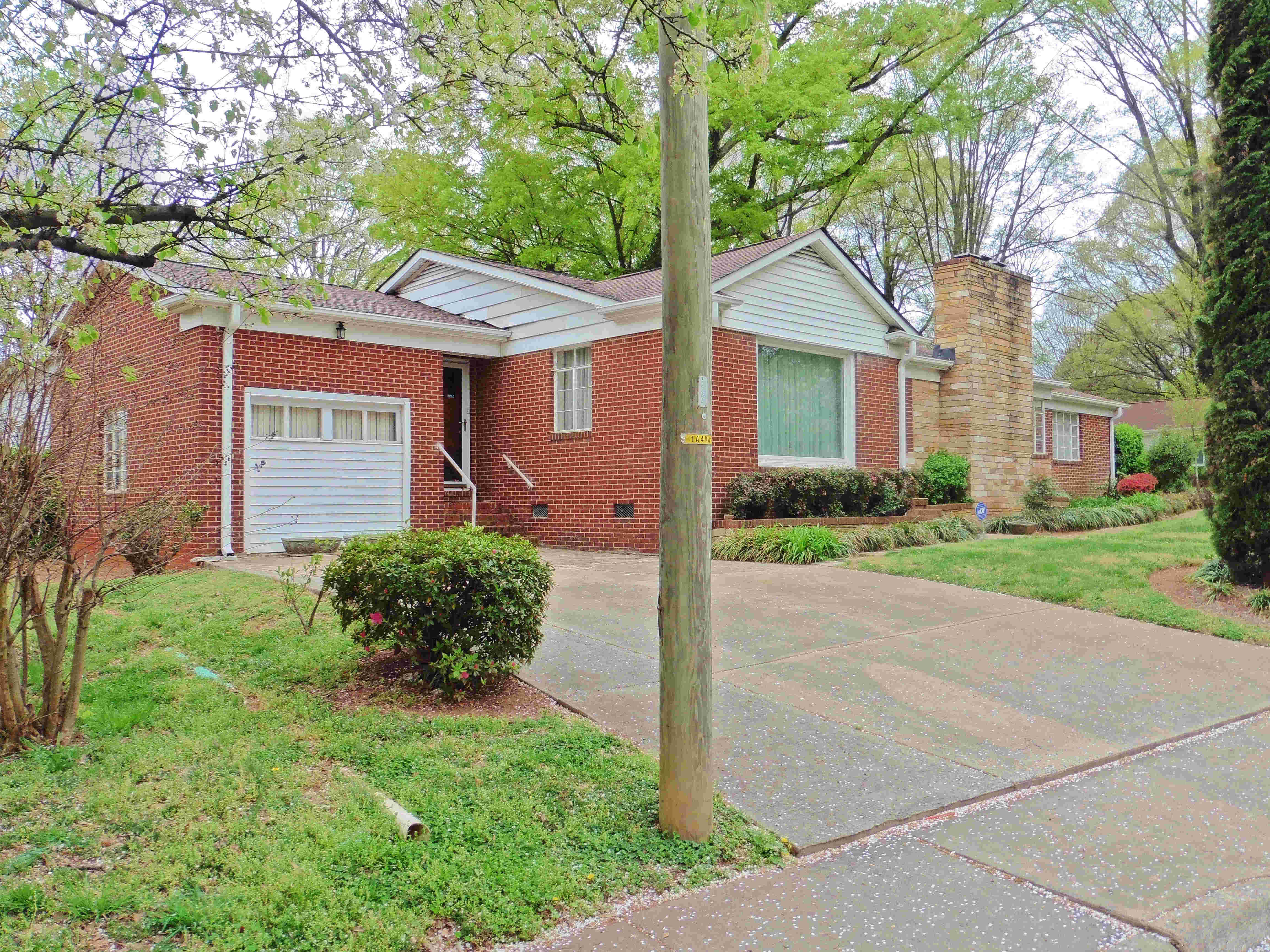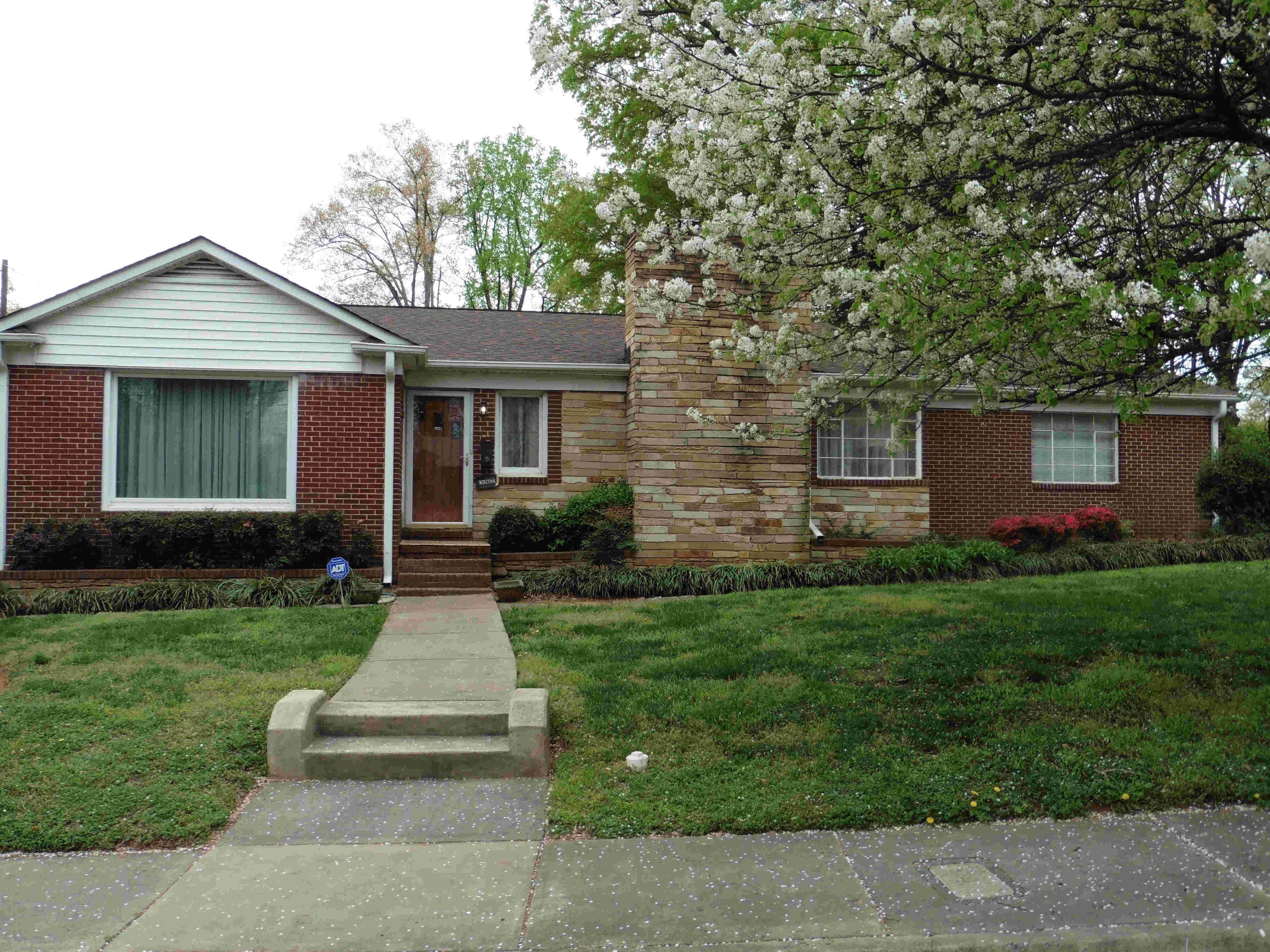1641 Oaklawn Avenue
 Built in 1949-50, first owner-occupants were physician Dr. Oliver B. Williams and his wife Ethel T. Later long-time residents Carson H. Beckwith and wife Ivestia “Peggy” Beckwith were well-known community leaders. He owned Band’s Beauty College, the first cosmetology school for African Americans in this region of the Carolinas. She was a radio personality and fashion model in her youth who became director of Charlotte’s Sickle Cell Disease Association. Mr. Beckwith’s son Calvin H. Beckwith became one of a group of three African American students in 1961 who integrated Charlotte College, today’s UNC Charlotte.
Built in 1949-50, first owner-occupants were physician Dr. Oliver B. Williams and his wife Ethel T. Later long-time residents Carson H. Beckwith and wife Ivestia “Peggy” Beckwith were well-known community leaders. He owned Band’s Beauty College, the first cosmetology school for African Americans in this region of the Carolinas. She was a radio personality and fashion model in her youth who became director of Charlotte’s Sickle Cell Disease Association. Mr. Beckwith’s son Calvin H. Beckwith became one of a group of three African American students in 1961 who integrated Charlotte College, today’s UNC Charlotte.
******
Oliver B. Williams hailed from Newberry, South Carolina, arriving in Charlotte to attend JCSU, Class of 1931. He played on the football team and joined Omega Psi Phi fraternity. He went on to Meharry Medical College in Nashville, which ranked alongside Howard University as the nation’s top medical school for African Americans. After a surgical residency in Kansas City, he returned to Charlotte.
A neighbor recalls that he died of a drug overdose, not an uncommon fate for doctors in an era when effects of many drugs were not yet well known nor well studied.
******
Subsequent owners of 1641 Patton Avenue were Carson Beckwith and his wife Peggy, who bought the house in 1956 and lived here over half a century.
Carson Hezekiah Beckwith (9.30.1909 – 9.9.2009) grew up on a farm in Craven County near New Bern, N.C., and went off to Durham to earn a degree at the North Carolina College for Negroes, now North Carolina Central University. He taught school for four years in rural eastern North Carolina, but began to imagine a different way to use his skills as an educator.
“A friend of mine named Robert Johnson and myself had a little car and we spent our weekends taking the young ladies from one little town to another to get their hair done because there was no beauty parlors near there,” he told oral history interviewer Erin Hunter in 2006. “This is how I got to desire to teach, or not just to teach, to own a beauty school. So I went to Brooklyn, September 1937, and entered Moler Beauty College…. You called it beauty culture, hairdressing, cosmetology, went under those three names. My desire for taking cosmetology was not designed to practice, but to teach others how to do it. “
New York City’s Moler Beauty College was part of a national chain of schools still in business today, founded by white barber A.B. Moler who is credited with starting the nation’s first barber academy. In 1939 Carson settled in Charlotte. The fast-growing city with its sizable African American population must have seemed a promising spot for a school which would take Moler’s educational program and adapt it for African American barbers, beauty operators and business entrepreneurs.
Beckwith opened Band’s Beauty College at an auspicious moment, just as the U.S. began to turn its mind back to civilian life after World War II. The first class graduated on May 25, 1945, with more than 100 students and numerous well-wishers crowding into Biddle Hall on the JSCU campus for the ceremony. Earning a cosmetology diploma took discipline and hard work; state officials required 1200 hours of study. Mrs. E.A. Spears, the financially well-connected spouse of North Carolina Mutual Insurance agent E.A. Spears, headed the institution’s business office.
By the time Carson moved into this house, Band’s Beauty College was the anchor tenant in the Dalebrook Professional Building, an office structure on Beatties Ford Road developed by a group of African American doctors, dentists and other professionals. Mr. Beckwith also founded the Charlotte Negro Chamber of Commerce with a fellow cosmetologist, Ned Davis, which met regularly from 1940 until at least 1957. It was just one of a constellation of organizations that he helped nurture, from Kappa Alpha Phi fraternity, to the North Carolina Cosmetologist Association which he co-founded in 1939 and remained an advisor to into the 1980s.
******
Ivestia Hegge Beckwith (5.18.23 – 2013), known as Peggy, became one of Charlotte’s social leaders. A native of Washington, N.C., she attended Bennett, the African American women’s college in Greensboro. According to her funeral program: “In the early 1940s she left North Carolina and moved to New York City where she enjoyed a successful modeling career through Sepia Arts Modeling Studios and worked for the Urban League. Her experience with the Urban League started her career endeavors understanding that being silent in the work place would not stop injustice. She fought for African American women to be included in the business and professional sectors as integral parts of the power process.”
She went on to Birmingham, Alabama, an emerging center for black activism. Angered by portrayals of African Americans on the radio, she walked into station WEDR to complain — and walked out with a job as one of the earliest African American women on radio. The white-owned station, which had begun in 1949, was in the process of becoming the nation’s second broadcaster to use all-black on-air talent. Radio in that era loved rhyming, so the station manager dubbed her “Peggy,” a play on her last name. Said her funeral program, “She enjoyed her 5pm radio show ‘Time for Peggy Heggie’ which she used to spotlight women with a voice.”
In 1964 she moved to Charlotte. With her radio and modelling background, she quickly found work in the public relations office at Johnson C. Smith University. She soon met Carson Beckwith, the busy businessman/educator/civic leader. His first wife, Margaret Demonde Beckwith, passed away in 1965 and in 1966 he and Peggy married.
“In the 70s she began to ponder the inequality of healthcare, especially health disparities, in the black community,” her funeral program continued. She began talking with local black physician C.W. Williams and with health officials about sickle cell disease, a blood disorder that strikes African Americans. They helped her launch Charlotte’s Association for Sickle Cell Disease in 1972, where she served as Executive Director for 31 years. She won federal grants for planning, treatment and community education, and worked with legislators to set up programs across North Carolina and as far away as Haiti.
A highlight of her sickle cell work came in the early 1980s. She and four fellow activists petitioned the U.S. Department of Health, Education and Welfare to set up a national grant program to fund community health clinics. Today, when most hospitals have networks of branches and clinics, it is hard to realize how radical the notion of a neighborhood healthcare facility was then. “In 1981, under the Sickle Cell grant, the CW Williams Community Health Center was opened to provide equal health care services to the underserved,” her funeral program stated with pride. Today in the 2010s the C.W. Williams Center continues in operation on Wilkinson Boulevard in west Charlotte.
Peggy and Carson Beckwith raised four children. Daughter Victoria Jean Beckwith Graham, who grew up in this house, became a community bridge-builder in her own right with Charlotte’s Afro-American Cultural Center (now Gantt Center for African American Arts and Culture) during the 1990s – 2000s. Calvin Hugh Beckwith, Caron’s son from his first marriage, became one of a group of three African American students — including Malachi Jerome Greene, whose parents lived at 1704 Patton Avenue in McCrorey Heights — who integrated Charlotte College in 1961, today’s UNC Charlotte.



Architecture
Ranch house. One-story, red-brick with wood clapboard gables and extensive field-stone decoration including a massive front chimney. Note the complicated massing, strong horizontal emphasis, large front picture window and also the large window that wraps around a corner adjacent to the chimney. This is one of the earliest and most stylish ranch examples in the neighborhood.
Building permits
Oaklawn-1631-1641-permit
Date issued: July 8, 1949
Owner: Thomas & Revis
Contractor: Thomas & Revis [also built 1627 Oaklawn]
Other permit info: to build residence
Building permit files, Robinson-Spangler Carolina Room, Charlotte Mecklenburg Library.
First appeared in city directory
1951 – Oliver B. Williams & Ethel T.
He: Physician at 420 E. 2nd. She: no occupation listed.
1981 – Carson H. Beckwith & Ivestia H.
He: Band’s Beauty College, 2506 Beatties Ford Road. She: Executive Director, Sickle Cell Disease Association, 951 S. Independence Boulevard
City directory collection at the Robinson-Spangler Carolina Room of the Charlotte Mecklenburg Library.
Obituaries
Beckwith, Peggy, Funeral program in the History Room, First United Presbyterian Church, Charlotte.
Resources
“A.B. Moler,” National Barber Museum and Hall of Fame website. On-line at: http://www.nationalbarbermuseum.org/about/hall-of-fame/18-1965-a-b-moler-illinois
Beckwith, Carson, oral history interview by Erin Hunter, December 1, 2006, UNC Charlotte. Audio on-line at: https://goldmine.uncc.edu/islandora/object/uncc%3A255. Transcript on-line at: https://goldmine.uncc.edu/islandora/object/uncc%3A260
Golden Bull Yearbook, 1931, p. 51.
“In a Nut-Shell,” Pittsburgh Courier, November 23, 1940.
“City College Accepts Negro Student,” Charlotte Observer, July 6, 1961.
“Opening Doors Integration Research Project: North Carolina,” Dedman College of Humanities and Sciences, Southern Methodist University. On-line at: http://www.smu.edu/Dedman/Academics/InstitutesCenters/EmbreyHumanRights/integration/nort hcarolina
WEDR radio. On-line at: http://wjldradio.com/wjld-history-1940s/ and http://wjldradio.com/wjld-history-1950s/
“Bi-Racial Unit Given Negro OK,” Charlotte Observer, October 17, 1957.
“Mrs. Carson Beckwith, Piano Teacher, Dies,” Charlotte Observer, June 29, 1965.
“Negro C of C to Open Drive,” Charlotte Observer, November 8, 1940.